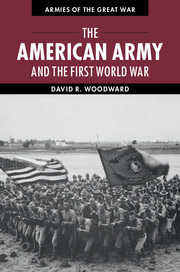Book contents
- Frontmatter
- Dedication
- Contents
- List of figures
- List of maps
- List of tables
- Preface
- List of abbreviations
- Introduction
- 1 Birth of a modern army
- 2 World war and American preparedness
- 3 Coercive power and Wilsonian diplomacy
- 4 “You’re in the army now”
- 5 US army doctrine and industrialized trench warfare
- 6 Over where?
- 7 American Expeditionary Force organization, overseas training, and deployment
- 8 Will the Americans arrive in time?
- 9 Failed expectations: “the military establishment of the United States has fallen down”
- 10 Atlantic ferry
- 11 Neck of the bottle
- 12 Uncertain times
- 13 Cantigny
- 14 Into the breach
- 15 American soldiers in north Russia and Siberia
- 16 The beginning of the end
- 17 Establishment of the American First Army and Saint-Mihiel
- 18 Meuse-Argonne, September 26–October 31
- 19 Breakout, November 1–11
- 20 Epilogue
- Notes
- Bibliography
- Index
- References
Notes
Published online by Cambridge University Press: 05 July 2014
- Frontmatter
- Dedication
- Contents
- List of figures
- List of maps
- List of tables
- Preface
- List of abbreviations
- Introduction
- 1 Birth of a modern army
- 2 World war and American preparedness
- 3 Coercive power and Wilsonian diplomacy
- 4 “You’re in the army now”
- 5 US army doctrine and industrialized trench warfare
- 6 Over where?
- 7 American Expeditionary Force organization, overseas training, and deployment
- 8 Will the Americans arrive in time?
- 9 Failed expectations: “the military establishment of the United States has fallen down”
- 10 Atlantic ferry
- 11 Neck of the bottle
- 12 Uncertain times
- 13 Cantigny
- 14 Into the breach
- 15 American soldiers in north Russia and Siberia
- 16 The beginning of the end
- 17 Establishment of the American First Army and Saint-Mihiel
- 18 Meuse-Argonne, September 26–October 31
- 19 Breakout, November 1–11
- 20 Epilogue
- Notes
- Bibliography
- Index
- References
- Type
- Chapter
- Information
- The American Army and the First World War , pp. 396 - 442Publisher: Cambridge University PressPrint publication year: 2014



